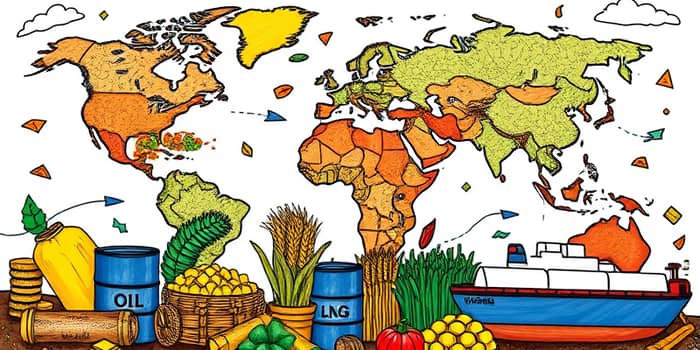
Commodities underpin virtually every aspect of modern life, from the energy that powers our homes to the metals that build our devices and the crops that feed billions. As global dynamics shift in 2025, a deep understanding of these markets becomes essential for stakeholders across industries.
At their core, commodities are basic goods used in commerce, interchangeable with others of the same specification and traded on public exchanges. They fall into two broad types: hard commodities and soft commodities.
Hard commodities originate from natural resources extracted or mined, while soft commodities are agricultural or livestock products that grow or are raised.
This classification helps analysts and investors tailor strategies to each sector’s unique risk and return profile.
Commodity markets operate through a network of physical and paper exchanges where price discovery occurs. Modern platforms link producers, consumers, speculators, and financial institutions in futures and spot markets.
Key instruments include forward contracts, futures, and options, each allowing participants to lock in prices or hedge against volatility.
Alongside these, digital innovations in trade documentation are streamlining settlements, reducing fraud, and enhancing transparency across cross-border transactions.
Commodities serve as both inputs and economic indicators. They act as inflation hedges and macroeconomic barometers, with rising prices often signaling increased demand or supply constraints.
In manufacturing and technology, metals like copper and aluminum are essential for construction and electronics, while energy commodities fuel industries and transportation. Agricultural commodities underpin food security and rural livelihoods worldwide.
Central banks and policymakers monitor commodity price movements closely, as they can influence monetary policy, fiscal planning, and social stability, especially in resource-dependent nations.
After a period of elevated volatility, aggregate commodity prices are expected to decline by about 12% in 2025, reaching a six-year low. Further contraction of another 5% is forecast for 2026 as global growth cools.
Energy markets face downward pressure on oil prices, with Brent crude forecast to average $74 per barrel. Metals show mixed dynamics: gold remains robust on central bank demand remains strong, while industrial metals such as copper and aluminum may see a rebound in 2026 amid renewed stimulus efforts.
Agricultural commodities remain well supplied, with soybeans and maize holding stocks-to-use ratios at multi-year highs. Wheat markets may tighten slightly, while rice prices are set to decline as export restrictions in India ease.
Natural gas demand is poised to surge, driven by growing LNG exports, particularly from the United States, bolstering energy security for Asian and European markets.
The outlook for 2025 hinges on several macroeconomic and geopolitical factors. Slowing global economic growth and sluggish demand, especially in China, weigh on commodity prices, while robust production in key regions sustains oversupply in many markets.
The decade from 2020 to 2024 has been described as the most volatile decade in half century for commodity prices. In 2025, any unexpected shock—whether an OPEC+ agreement unraveling or a major geopolitical incident—could trigger sharp price swings.
Supply chain resilience has become paramount. Companies are making strategic moves to secure resilient supply chains by diversifying sourcing, investing in inventory buffers, and forging long-term supplier partnerships.
Digitization is transforming trade finance and risk management. The adoption of digital trade documentation adoption accelerates settlements and reduces operational friction, particularly for emerging market producers.
Climate change and sustainability concerns are giving rise to new commodity-linked financial products. The emergence of carbon credits and certificates has created fresh investment opportunities and regulatory frameworks, as global emissions markets mature.
Nontraditional players—including hedge funds, private equity, and graphene-backed fintech startups—are entering commodity finance, offering off-balance sheet solutions and fostering competition in trade lending.
As we navigate 2025, commodity markets remain a dynamic nexus of opportunity and risk. Investors and policymakers must balance the downward pressure from economic slowdowns with the long-term demand driven by the energy transition and technological innovation.
Staying informed about market fundamentals, monitoring key drivers, and leveraging digital tools for transparency can help stakeholders make informed decisions in turbulent markets. With volatility likely to persist, a strategic, long-term perspective will be essential to capitalize on emerging trends and safeguard against downside risks.
Ultimately, understanding the intricate web of supply chains, policy influences, and technological shifts will enable participants to thrive in a world where raw materials continue to shape our collective future.
References





